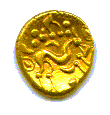|
|
|
Celtic coins are
artistic monuments - astonishingly modern - and you will see in
them lines and forms that were collected by surrealist painters
and writers, like André Breton, whose collection of Celtic coins
was much admired by Picasso.Celtic coins are often made of bronze,
sometimes of silver and gold. They are often common and are to be
found for sale at a hundred francs ( twenty dollars ) upwards.
Sometimes they are so rare and important that the prices are very
high. The most expensive was sold for four hundred thousand
francs ( seventy thousand dollars ) ; it was the gold 'stater'
struck, just before his defeat, by Vercingetorix, king of the
Gauls, who was besieged by Julius Caesar. Only four examples are
to be found outside of museums and this was one of the finest.
Celtic coins picture animals, gods, humans. The horse and the
boar are frequently depicted for they were the companions of the
soldier and of the hunter . The eagle also quite often features.
It is difficult to distinguish between gods and men, for these
coins rarely have a legend and the faces of our ancestors,
represented on coins, could be those of men or of gods, without
our being able to differentiate . The symbolic stars are often
present, especially the sun and the moon with imaginary animals,
half-human, half-beast like the representations of Taranus and
Belenus.
How
were Celtic coins made?
Celtic coins were produced in two ways, conventionally described
as struck and cast. Both methods required a considerable degree
of technical knowledge to ensure successful results.The process
of striking a coin began with the production of a blank. This was
probably formed in a clay mould, but it is still uncertain how
the metal alloy was placed in the mould. It probably wasn't
poured in, which would make precise weight control difficult, but
perhaps put into the mould in powder or nugget form, or possibly
as sections from carefully measured ingots.
After the metal had been heated in the mould it would have to be
flattened before striking. The temperature at which this could be
achieved would be influenced by the composition of the alloy. The
flattened blank or flan would then be placed on a concave obverse
die - to keep the blank in place - and struck with the convex
reverse die, as the diagram below shows. The dies tended to be
much bigger than the area of the flan, so that often only a part
of the design shows on the resulting coin. Celtic dies were made
of iron and/or bronze. They are extremely rare, since they were
clearly carefully looked after while they were in use, and thus
very rarely lost, and they were often used to destruction.. The
quality of engraving on many dies is superb, and it is difficult
to imagine how some tiny details were engraved on dies just a few
millimetres in diameter. The engraving ability of the moneyers
was matched by their control of the weight and alloy of the
coinage. They were capable of producing thousands of coins
deviating just a few milligrams each side of the intended weight,
and they could make subtle alterations to the quality of the
alloy, masking a decrease in the precious metal content.
Most gold and silver Celtic coins also occur as plated forgeries.
They were produced by coating a base metal core with gold or
silver alloy before striking took place, either by dipping the
core in molten alloy, or by hammering a thin layer of gold or
silver around the core until it bonded with the base metal. Dies
used for genuine coins were sometimes also used for plated
examples; alternatively, dies could be faked by making a cast
from a mould bearing the impression of a genuine coin, or by
pressing a genuine coin into soft metal which was then hardened
to form a die; sometimes the design of a coin was simply copied
onto a new die, resulting in the reversal of the correct image.
The production of cast coins required very different techniques.
The cast coins from south-east Britain were produced by pouring
molten alloy into a set of moulds joined by runners, which were
broken apart when the metal had cooled. The breaks were not
always neat and often parts of the sprue - the joining portion
between the coins - remain attached to the coin itself. The
earliest examples of these coins in Britain have relatively fine
images, which were presumably made by pressing a coin into the
mould. As this process was successively repeated, the quality of
the image being reproduced became ever worse, eventually becoming
a featureless blob.

Gold
Gallo-Belgic Stater
Ambiani Type E Stater (c. 57-45
B.C.)
In terms of English coins this is as old as you normally find. It
appears on page 1 of Seaby's excellent "Coins of England"
book. The coin depicts a disjointed horse with pellets above and
below. The obverse is blank on this particular stater.

Celtic
Silver Coin
This is a silver coin of the
Celtic leader Tasciovanus. The obverse has the word VER in beaded
circle which refers to Verulamium (St.Albans) This coin was
minted between 20 BC and 10 AD. The reverse shows a horse.
The Find Pages And Other Links